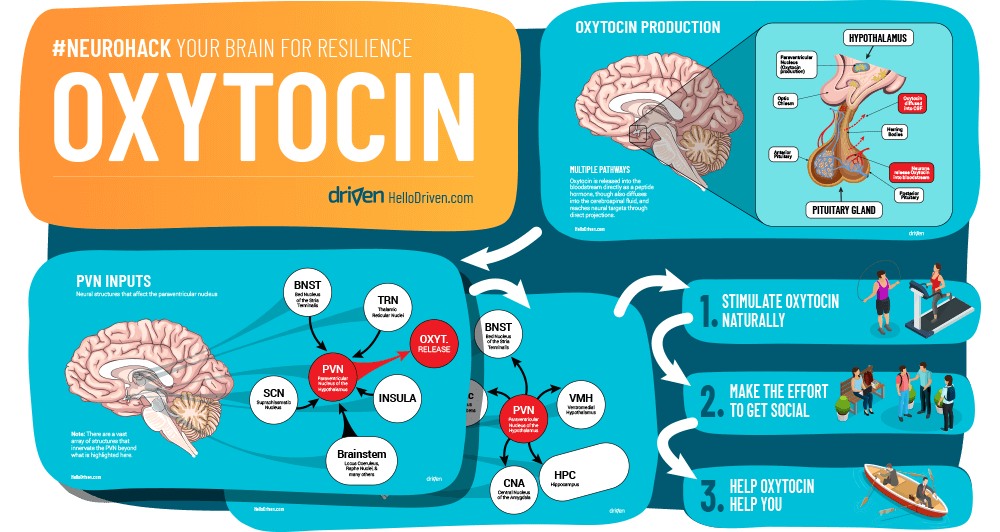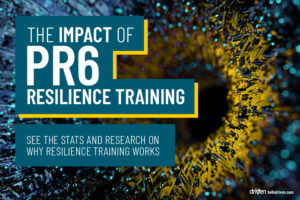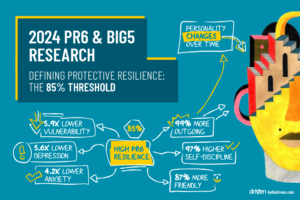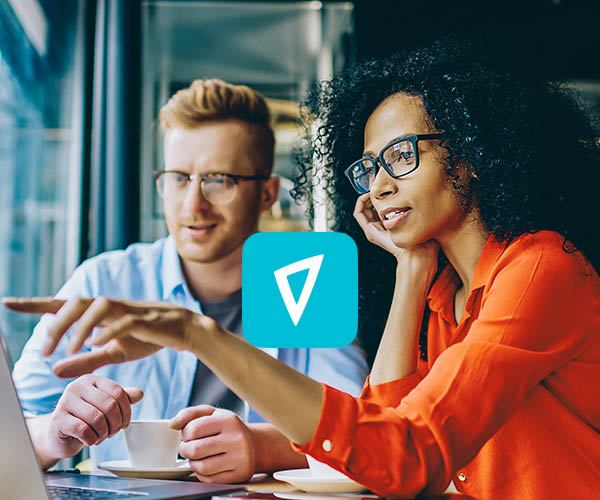Oxytocin is often thought of as the chemical of looove. However, it has many other roles (empathy, stress, optimism) that are worth exploring. I don’t often see oxytocin discussed in the context of resilience, so I decided to dig into the extensive (and sometimes hilarious) research done on oxytocin.
Today we’ll be looking beyond its usual roles – baby bonding and childbirth – and see instead how it affects our capacity to be resilient in the face of adversity.
How does oxytocin affect our social connections and support network? How does it affect our outlook on life? How does it affect our ability to manage stress? Since oxytocin is easily administered through a nasal spray, it means there is lots of research on all of this, so let’s get into it!
Want to decrease stress & anxiety and improve your own resilience? Get the Driven app.
What & Where?
Oxytocin is produced mainly in the paraventricular nucleus (PVN) of the hypothalamus. From there it is stored inside small bubbles called Herring bodies in neurons of the posterior pituitary. The Herring bodies store the oxytocin until ready to release through the axon terminal into the bloodstream.
From here, oxytocin travels as a peptide hormone to distant areas in body, innervating all types of different organs with oxytocin receptors. Similar to norepinephrine, oxytocin is released into the bloodstream and also interacts with neural tissue.
This means that oxytocin is both a peptide hormone, and a neuropeptide.
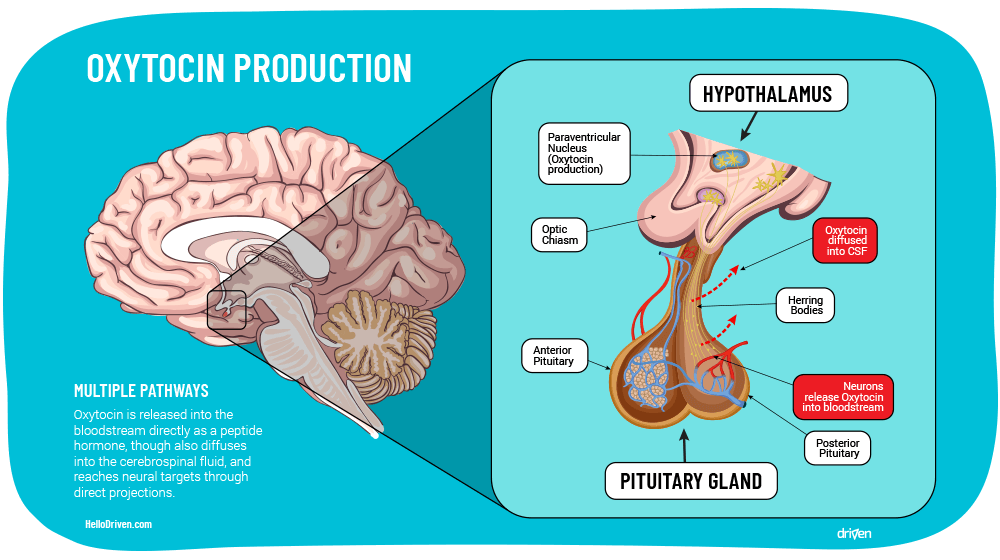
What are its effects
Variation in oxytocin system effectiveness has a surprisingly large number of effects. Here are just a few highlights of oxytocin’s involvement across many different aspects of human experience.
Physical effects
Suppresses appetite[1]
Increases lactation, reduces excretion of urine, preparation of foetal neurons for delivery
Social
Increases trust[2]
Increases empathy[3]
And curiously, increases group-favouring dishonesty (lying to benefit your own group), an interesting ethical side-effect of oxytocin’s role in social cohesion[4]
Relationships
Increases secure attachment behaviour[5]
Increases relationship fidelity and social distancing when in a monogamous relationship[6]
Affects likely age of first sexual experience (alongside the closely related arginine vasopressin receptor 1A)[7]
Fear & anxiety
Reduces fear and anxiety in some circumstances, such as being more social[8]
However, it may elicit fear at other times, such as after being humiliated[9]
Mood & depression
Has an antidepressant-like effect, potentially through its role of prosocial behaviour[10]
The complex role of oxytocin on fear and anxiety is a very interesting aspect. It can reduce our fear of being social, but it can also create fear where we feel we’ve been humiliated, or ‘socially defeated’. Perhaps this comes in with oxytocin’s pro-group role, pushing us to be part of the group, and if the group doesn’t want us, to withdraw from the group.
What’s important to us here from the perspective of resilience, is how a high functioning oxytocin system allows us to build strong connections and support networks, protects us against anxiety and depression, and maintains a healthy body as the foundation to thrive.
Inputs Into the PVN
On a mechanistic level, oxytocin release is mainly influenced by inputs into the PVN. These projections into the PVN gives us clues about what influences the release (or inhibition) of oxytocin[11].
Many nuclei in the brainstem, including the locus coeruleus (LC – norepinephrine) projects into the PVN. Others such as the raphe nuclei (RN) provides serotonergic stimulation of the PVN. These brainstem nuclei inputs are largely related to visceral functions, stress (decrease oxytocin) and arousal (increase oxytocin)
The thalamic reticular nucleus (TRN) which sits as a layer over the thalamus also projects into the PVN. The TRN is involved with mediating attention and also gustatory signals (food & drink)
Many nuclei within the hypothalamus projects into the PVN. One of interest is the suprachiasmatic nucleus (SCN), which is effectively our circadian pacemaker. We find here that PVN activity is higher during the day as a result of these rhythms
Cortical inputs from areas such as the insula (emotion processing) also play an important role. This may help to decipher social context (do we like who we’re talking to, how is this conversation going, etc) and provide an appropriate behavioural response
The bed nucleus of the stria terminalis (BNST) is involved in anxiety in response to threat monitoring. The BNST is not involved in sudden frightful responses, but rather only activates in longer situations (10 mins+). In fact, the BNST might even be more important for psychological disorders than the amygdala[12]. The BNST projects into the PVN (GABA) as part of the hypothalamic-pituitary-adrenal axis activation. This here should be a hint that oxytocin is not just a feel-good hormone
In addition to all these, a very long list of peptides also interact with the PVN, highlighting to us that social interaction is highly complex. The sheer volume of inputs into the PVN means that we don’t have a full understanding of all the ways it can be activated or inhibited. So, we need to rely on more observational data to help us make sense of this!

Oxytocin Outputs in the Brain
As a peptide hormone and neuropeptide, oxytocin makes its mark both through direct and indirect pathways. Direct pathways are those neural projections from the hypothalamus to specific neural structures elsewhere, while indirect pathways are reached through oxytocin’s release into the bloodstream and into cerebrospinal fluid.
For oxytocin to have an effect, there needs to be oxytocin receptors (OXTR). These receptors bind with oxytocin release and thereby adjusts the firing of the neurons in the targeted structure. These receptors exist in many areas that is projected to directly, including:
The central amygdala (CNA). This is where oxytocin has a complex relationship with reduction of fear, while sometimes also causing fear, depending on the social context and historical events
The hippocampus is influenced through oxytocin to stimulate neurogenesis which may assist with memory formation and consolidation[13]
The ventromedial hypothalamus (VMH) has also been found to contain OXTR, influencing the termination of hunger[14], and affects sexual activity[15]
Inside the nose, the septum (the cartilage that keeps your nostrils apart) has OXTR, which is why researchers so enjoy delivering oxytocin through nasal sprays. And yes, the means you can to some extent ‘smell’ oxytocin on someone else[16]
The BNST is involved in anxiety in response to threat monitoring. The BNST is not involved in sudden frightful responses, but rather only activates in longer situations (10 mins+). Oxytocin release helps to downregulate the BNST, serving to alleviate social anxiety. On the other hand, less oxytocin binding negatively affects social ability[17]
The nucleus accumbens (NAc) plays a big role in motivation and also addiction, resulting in some curious effects through OXTR. Let’s dig into this one more a little later.
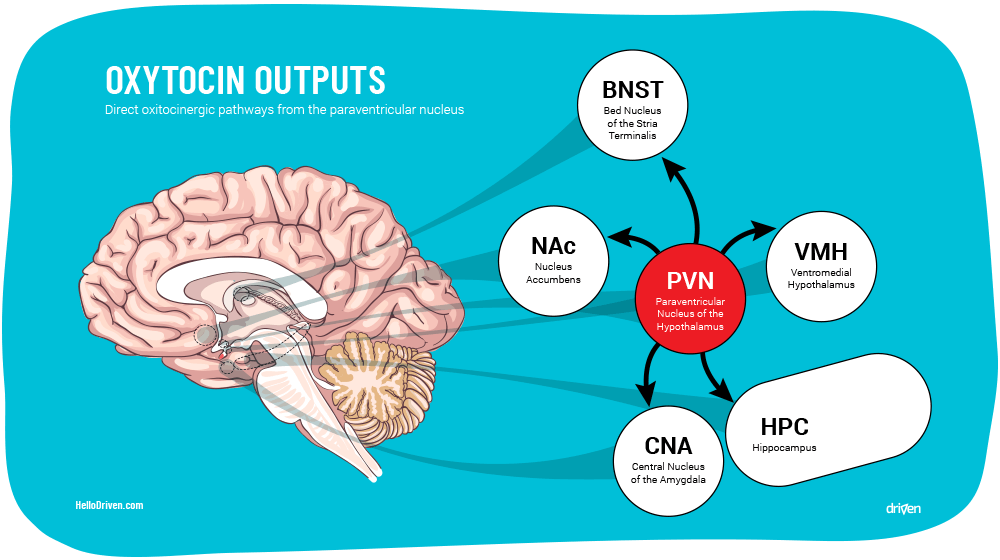
Genetically Social
Single-nucleotide polymorphisms (SNP, often called ‘snips’) are genetic variations that often occur in a specific point in the genome. Recall that genes are encoded by combinations of the nucleotide codes G, A, T & C.
An interesting SNP related to the OXTR gene is rs53576. This SNP expresses as GG, AG or AA. These variations impact the effectiveness of the oxytocin system and its related impact on neural structures with oxytocin receptors.
If your rs53576 gene is GG, then it means your oxytocin system likely works better than someone with AA or AG alleles. In fact, here are some traits associated with the different genes:
People with GG are more likely to be optimistic and have higher self-esteem[18]
GG people are more social and outgoing (though this doesn’t affect close relationships)[19]
GG people can handle stress more effectively and tend to have more empathy[20]
And the list goes on an on about the benefits of GG. So, you might be wondering, how many people have GG. Well, you might be surprised to find our that only 40% of people have this SNP variation. Meaning more than likely, you have AA or AG.
Hmm. What to do about this?
Make That EPIgenetically Social
Now that you’re probably worried about your rs53576 SNP, the good news is that the OXTR gene (including that SNP) is under epigenetic control. What does this mean? It means that the expression of this gene can be changed. For example, through epigenetics a high functioning AA SNP can potentially be more effective than a low functioning GG SNP.
Being born with a certain set of genes doesn’t mean you are doomed to be a certain way. In fact, many recent studies have shown that epigenetic modification of the OXTR gene creates important differences in oxytocin effectiveness, opening the pathway to reduce stress, build better relationships, enjoy social situation more, and so on[21].
Neurochemicals help us understand why certain behaviours manifest together and what we can practically do about them
Epigenetic modification is useful to remember for two reasons:
It means there is always hope to improve whatever situation you are in. Through directed effort you can change who you are.
It also means to never rest on your laurels. Even if you are blessed with all the best genes, if you don’t actively practise these, you will lose the benefit you can get from them.
This is the constant reminder that resilience is about practise. All the skills that enable us to be resilience requires ongoing practise and attention. The effects of this virtuous effort are manifested in the brain through helpful neural pathways and the epigenetic activation of genes that boost your resilience capacity.
Monogamy Therapy, Anyone?
Now that we’ve talked a bit about genetics, let’s get back to OXTR in the nucleus accumbens. Consider the tale of two voles. The prairie vole is monogamous and mates for life. Meanwhile, the montane vole lives a polygamous lifestyle.
Looking into their tiny brains, scientists found that, compared to montane voles, the monogamous prairie voles have far more OXTR plus the closely-related vasopressin V1a receptors (V1aR) in the nucleus accumbens. What does this mean? It means that voles effectively get ‘addicted’ to their partners. They crave the oxytocin release from being around their partner.
Once the prairie vole selects a mate, epigenetic changes to gene expression results in more OXTR and V1aR being inserted to the nucleus accumbens, now setting them up for a monogamous life. This is interesting to us, because it helps us understand how humans maintain relationships as well[22].
But, what if you can change this? Given the ability to change expression of these genes through epigenetics, could we induce monogamy in the polygamous montane vole? Of course! (this research cracks me up)
Through use of a viral vector, researchers introduced V1aR into the nucleus accumbens of the montane vole. And wouldn’t you know it, this reduced promiscuity in favour of more monogamous behaviour[23]!
Can you imagine – a whole new industry for Viral Vector Monogamy Therapy (VVMT), increasing the ability of couples to stay together forever. A new multi-billion dollar industry, maybe?
Trauma Reduces Oxytocin
It should come as little surprise that experience of trauma reduces oxytocin system functioning, resulting in reduced oxytocin levels[24]. Emotional trauma and PTSD also reduces oxytocin levels[25]. Here again we see the complex relationship of oxytocin with fear, as people who have recently experienced trauma are more likely to re-experience traumatic symptoms.
Genetics play a role in this. Previously, GG alleles were shown to be protective in many ways. However, people with GG alleles who experience emotional trauma or PTSD tend to have more negative outcomes as compare to people with AA alleles. It seems that the increased sociality of GG types mean that violation is experienced more personally.
Oxytocin is not simply a feel-good hormone. It has many powers for improved wellness, but it can be unhelpful. While previously a hug would release oxytocin and create a positive effect, after a recent traumatic event, that same release of oxytocin from a hug can trigger a flashback[26]. This can be very confusing, so helping clients and their supporters understand what is happening here with oxytocin in the brain can ease this confusion.
Practical Oxytocin
Our interested in neurochemicals goes beyond the chemicals themselves towards the neural structures and pathways that are innervated (or inhibited) by their release.
Through this, neurochemicals give us a view into flow-on effects of its release, helping us understand why certain behaviours manifest together and what we can practically do about them.

1. Stimulate oxytocin naturally
There are many ways to directly increase oxytocin levels. By doing this, you can enjoy the benefits of oxytocin through all its various effects.
Listening to music[27] has been shown to increase oxytocin, having been used as post therapy in cardiac surgery patients. Switching on some good tunes is a great way to relax and lift your mood
Doing exercise[28], whether cardiovascular, or yoga, or probably anything that gets your heart rate up and gets you moving. Plus, you don’t just get the benefit of oxytocin, but also build towards a healthier you
Getting a massage[29] increases oxytocin as well, involving a combination of relaxation, physical touch, and getting your blood flowing
Drinking coffee[30] interestingly also results in the release of oxytocin due to the effects of caffeine, so no wonder it helps you enjoy life a little more!
Key PR6 Skill – Health

2. Make the effort to get social
Spending time with people – in particular, having positive social experiences – increases oxytocin release[31]. The important aspect about this in relation to resilience is that this is how we build a strong support network. It is this network that we can rely on when we need help to overcome life’s bigger challenges.
Building a strong network means spending time with people again and again, strengthening relationships over time. Good relationships require ongoing investment, and in that way, oxytocin helps us to socialise by making the process more pleasurable, reducing stress and helping us feel good about ourselves.
Even when people are not around, interacting with pets – like playing with a dog – increases oxytocin[32]. Pets provide constant companionship and affection, which is exactly what we as social being crave from other people as well. So, make the time for social things, even if it’s with your dog!
Key PR6 Skill – Collaboration

3. Help oxytocin help you
Just as oxytocin can help us be bolder socially, so too do we need the other aspects of resilience to protect us against perceptions of social defeat, defending against the potential fear-inducing effect of oxytocin. Practically, being more self-secure means less likelihood that you would experience any kind of humiliation that could trigger fear caused by oxytocin.
Being able to laugh at yourself and your own mis-steps therefore protects you against the downsides of oxytocin, and helps you maximise the upside. In this way, resilience helps oxytocin act in ways that is always useful to you.
Oxytocin can also amplify memories both positively and negatively[33]. Therefore, taking the time to introspect and constructively work through past memories is important, as this provides a healthier basis on which oxytocin can work, helping you feel more positive about the past.
Key PR6 Skill – Reasoning, Vision
Conclusion
Our hormone of love turns out to be quite complex, with a lot of positive aspects to it, but also potentially some negative ones if we aren’t careful. There are many ways for us to directly influence our oxytocin levels, providing us with pathways to use this in a constructive way to help manage anxiety, stress, mediate depression, and build resilience overall.
While we may be predisposed to be some way through genetics, the important role of epigenetic changes due to our environment and our personal efforts is the key reminder to keep going. Don’t give up on social situations and investing in a support network, even if it’s hard. No matter how small, we all have some resilience, and we can keep building on that over and over until we develop deep inner strength.
Until next time, all the best!
Jurie
1. Atasoy, D., Betley, J. N., Su, H. H., & Sternson, S. M. (2012). Deconstruction of a neural circuit for hunger. Nature, 488(7410), 172.
2. Lane, A., Luminet, O., Rimé, B., Gross, J. J., de Timary, P., & Mikolajczak, M. (2013). Oxytocin increases willingness to socially share one’s emotions. International Journal of Psychology, 48(4), 676-681.
3. Rodrigues, S. M., Saslow, L. R., Garcia, N., John, O. P., & Keltner, D. (2009). Oxytocin receptor genetic variation relates to empathy and stress reactivity in humans. Proceedings of the National Academy of Sciences, 106(50), 21437-21441.
4. Shalvi, S., & De Dreu, C. K. (2014). Oxytocin promotes group-serving dishonesty. Proceedings of the National Academy of Sciences, 201400724.
5. Insel, T. R., & Young, L. J. (2001). The neurobiology of attachment. Nature Reviews Neuroscience, 2(2), 129.
6. Scheele, D., Striepens, N., Güntürkün, O., Deutschländer, S., Maier, W., Kendrick, K. M., & Hurlemann, R. (2012). Oxytocin modulates social distance between males and females. Journal of Neuroscience, 32(46), 16074-16079.
7. Prichard, Z. M., Mackinnon, A. J., Jorm, A. F., & Easteal, S. (2007). AVPR1A and OXTR polymorphisms are associated with sexual and reproductive behavioral phenotypes in humans. Human mutation, 28(11), 1150-1150.
8. Kirsch, P., Esslinger, C., Chen, Q., Mier, D., Lis, S., Siddhanti, S., … & Meyer-Lindenberg, A. (2005). Oxytocin modulates neural circuitry for social cognition and fear in humans. Journal of neuroscience, 25(49), 11489-11493.
9. Guzmán, Y. F., Tronson, N. C., Jovasevic, V., Sato, K., Guedea, A. L., Mizukami, H., … & Radulovic, J. (2013). Fear-enhancing effects of septal oxytocin receptors. Nature neuroscience, 16(9), 1185.
10. McQuaid, R. J., McInnis, O. A., Abizaid, A., & Anisman, H. (2014). Making room for oxytocin in understanding depression. Neuroscience & Biobehavioral Reviews, 45, 305-322.
11. Kirouac, G. J. (2015). Placing the paraventricular nucleus of the thalamus within the brain circuits that control behavior. Neuroscience & Biobehavioral Reviews, 56, 315-329.
12. Lebow, M. A., & Chen, A. (2016). Overshadowed by the amygdala: the bed nucleus of the stria terminalis emerges as key to psychiatric disorders. Molecular psychiatry, 21(4), 450.
13. Lin, Y. T., Chen, C. C., Huang, C. C., Nishimori, K., & Hsu, K. S. (2017). Oxytocin stimulates hippocampal neurogenesis via oxytocin receptor expressed in CA3 pyramidal neurons. Nature communications, 8(1), 537.
14. Klockars, O. A., Waas, J. R., Klockars, A., Levine, A. S., & Olszewski, P. K. (2017). Neural basis of ventromedial hypothalamic oxytocin-driven decrease in appetite. Neuroscience, 366, 54-61.
15. Kurrasch, D. M., Cheung, C. C., Lee, F. Y., Tran, P. V., Hata, K., & Ingraham, H. A. (2007). The neonatal ventromedial hypothalamus transcriptome reveals novel markers with spatially distinct patterning. Journal of Neuroscience, 27(50), 13624-13634.
16. Wacker, D. W., & Ludwig, M. (2012). Vasopressin, oxytocin, and social odor recognition. Hormones and behavior, 61(3), 259-265.
17. Dumais, K. M., Alonso, A. G., Immormino, M. A., Bredewold, R., & Veenema, A. H. (2016). Involvement of the oxytocin system in the bed nucleus of the stria terminalis in the sex-specific regulation of social recognition. Psychoneuroendocrinology, 64, 79-88.
18. Saphire-Bernstein, S., Way, B. M., Kim, H. S., Sherman, D. K., & Taylor, S. E. (2011). Oxytocin receptor gene (OXTR) is related to psychological resources. Proceedings of the National Academy of Sciences, 201113137.
19. Li, J., Zhao, Y., Li, R., Broster, L. S., Zhou, C., & Yang, S. (2015). Association of oxytocin receptor gene (OXTR) rs53576 polymorphism with sociality: a meta-analysis. PLoS One, 10(6), e0131820.
20. Rodrigues, S. M., Saslow, L. R., Garcia, N., John, O. P., & Keltner, D. (2009). Oxytocin receptor genetic variation relates to empathy and stress reactivity in humans. Proceedings of the National Academy of Sciences, 106(50), 21437-21441.
21. Kumsta, R., Hummel, E., Chen, F. S., & Heinrichs, M. (2013). Epigenetic regulation of the oxytocin receptor gene: implications for behavioral neuroscience. Frontiers in neuroscience, 7, 83.
22. McGraw, L. A., & Young, L. J. (2010). The prairie vole: an emerging model organism for understanding the social brain. Trends in neurosciences, 33(2), 103-109.
23. Lim, M. M., Wang, Z., Olazábal, D. E., Ren, X., Terwilliger, E. F., & Young, L. J. (2004). Enhanced partner preference in a promiscuous species by manipulating the expression of a single gene. Nature, 429(6993), 754.
24. Heim, C., Young, L. J., Newport, D. J., Mletzko, T., Miller, A. H., & Nemeroff, C. B. (2009). Lower CSF oxytocin concentrations in women with a history of childhood abuse. Molecular psychiatry, 14(10), 954.
25 & 25. Donadon, M. F., Martin-Santos, R., & Osório, F. D. L. (2018). The associations between oxytocin and trauma in humans: a systematic review. Frontiers in pharmacology, 9, 154.
27. Nilsson, U. (2009). Soothing music can increase oxytocin levels during bed rest after open‐heart surgery: a randomised control trial. Journal of clinical nursing, 18(15), 2153-2161.
28. Irianti, S., Ginandjar, A. B., Krisnadi, S. R., Effendi, J. S., Nataprawira, D., & Gandamihardja, S. (2017, March). Aerobic Exercise and Its Effect on Oxytocin Level and Labor Progression. In IOP Conference Series: Materials Science and Engineering (Vol. 180, No. 1, p. 012177). IOP Publishing.
29. Morhenn, V., Beavin, L. E., & Zak, P. J. (2012). Massage increases oxytocin and reduces adrenocorticotropin hormone in humans. Alternative therapies in health and medicine, 18(6), 11.
20. Wu, L., Meng, J., Shen, Q., Zhang, Y., Pan, S., Chen, Z., … & Zhang, G. (2017). Caffeine inhibits hypothalamic A 1 R to excite oxytocin neuron and ameliorate dietary obesity in mice. Nature communications, 8, 15904.
31. Uvnäs-Moberg, K. (1998). OXYTOCIN MAY MEDIATE THE BENEFITS OF POSITIVE SOCIAL INTERACTION AND EMOTIONS1. Psychoneuroendocrinology, 23(8), 819-835.
32. Odendaal, J. S., & Meintjes, R. A. (2003). Neurophysiological correlates of affiliative behaviour between humans and dogs. The Veterinary Journal, 165(3), 296-301.
33. Bartz, J. A., Zaki, J., Ochsner, K. N., Bolger, N., Kolevzon, A., Ludwig, N., & Lydon, J. E. (2010). Effects of oxytocin on recollections of maternal care and closeness. Proceedings of the National Academy of Sciences, 107(50), 21371-21375.
